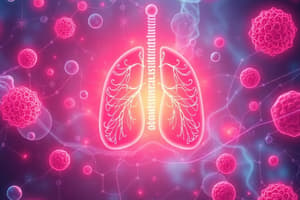Podcast
Questions and Answers
What is the net yield of ATP from one molecule of glucose undergoing glycolysis?
What is the net yield of ATP from one molecule of glucose undergoing glycolysis?
- Four molecules of ATP
- Zero molecules of ATP
- Six molecules of ATP
- Two molecules of ATP (correct)
What is produced alongside reduced NAD during glycolysis?
What is produced alongside reduced NAD during glycolysis?
- Lactate
- Carbon Dioxide
- Pyruvate (correct)
- Oxygen
Which condition allows glycolysis to proceed without interruption?
Which condition allows glycolysis to proceed without interruption?
- High ATP concentrations
- Presence of oxygen
- Re-oxidation of NAD (correct)
- Presence of organelles
What is the final product of glycolysis?
What is the final product of glycolysis?
Where does glycolysis occur within the cell?
Where does glycolysis occur within the cell?
What is the purpose of adding phosphate molecules during glycolysis?
What is the purpose of adding phosphate molecules during glycolysis?
What happens to pyruvate in the absence of oxygen after glycolysis?
What happens to pyruvate in the absence of oxygen after glycolysis?
Which stage of aerobic respiration occurs after glycolysis?
Which stage of aerobic respiration occurs after glycolysis?
In anaerobic respiration in yeast, what are the by-products of pyruvate metabolism?
In anaerobic respiration in yeast, what are the by-products of pyruvate metabolism?
During the oxidation of triose phosphate in glycolysis, which carrier molecule is involved?
During the oxidation of triose phosphate in glycolysis, which carrier molecule is involved?
Flashcards are hidden until you start studying
Study Notes
Aerobic Respiration Stages
- Respiration consists of four main stages: Glycolysis, Link Reaction, Krebs Cycle, and Oxidative Phosphorylation.
- Glycolysis converts one 6-carbon glucose into two 3-carbon pyruvate molecules.
- The Link Reaction transforms pyruvate into carbon dioxide and acetyl coenzyme A (acetyl CoA).
- Krebs Cycle involves acetyl CoA in a series of eight enzyme-catalysed reactions, producing reduced NAD, FAD, and ATP.
- Oxidative Phosphorylation utilizes reduced NAD and FAD in the electron transport chain, requiring oxygen and producing water.
Anaerobic Respiration
- Anaerobic respiration includes glycolysis but omits the Link Reaction, Krebs Cycle, and Oxidative Phosphorylation.
- In mammals, pyruvate from glycolysis is converted into lactate.
- In yeast, pyruvate is converted into ethanol and carbon dioxide.
Glycolysis Overview
- Glycolysis occurs in the cytoplasm of all multicellular and many unicellular organisms.
- It converts a hexose sugar (glucose) into two 3-carbon molecules (pyruvate), involving ten smaller enzyme-controlled reactions grouped into four stages.
Stages of Glycolysis
- Activation of Glucose:
- Glucose is phosphorylated using two ATP molecules, forming fructose 1,6-bisphosphate; this makes glucose reactive and prevents its exit from the cell.
- Splitting of Phosphorylated Sugar:
- Fructose 1,6-bisphosphate splits into two molecules of triose phosphate.
- Oxidation of Triose Phosphate:
- Hydrogen is removed from triose phosphate and transferred to NAD+ to produce reduced NAD.
- Production of ATP:
- Conversion of triose phosphate to pyruvate yields four ATP (net gain of two) and two molecules of reduced NAD.
Net Yield from Glycolysis
- From one glucose molecule, glycolysis results in:
- Two net molecules of ATP.
- Two molecules of reduced NAD, which can produce more ATP.
- Two molecules of pyruvate.
Significance of Glycolysis
- Glycolysis is one of the earliest biochemical pathways and operates without organelles or membranes.
- It functions anaerobically, allowing organisms to utilize alternative pathways such as fermentation in the absence of oxygen.
- Pyruvate can be further broken down in the Krebs Cycle to release additional energy, particularly in aerobic conditions.
Studying That Suits You
Use AI to generate personalized quizzes and flashcards to suit your learning preferences.




